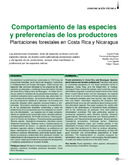| dc.contributor.author | Piotto, Daniel | |
| dc.contributor.author | Montagnini, Florencia | |
| dc.contributor.author | Kanninen, Markku | |
| dc.contributor.author | Ugalde, Luis | |
| dc.contributor.author | Víquez, Edgar | |
| dc.date.accessioned | 2021-03-04T19:29:36Z | |
| dc.date.available | 2021-03-04T19:29:36Z | |
| dc.date.issued | 2002-04 | |
| dc.identifier.citation | e-ISSN: 1021-0164 | es_ES |
| dc.identifier.uri | https://repositorio.catie.ac.cr/handle/11554/10393 | |
| dc.description | 8 páginas, 1 ilustraciones, 8 tabulaciones, 25 referencias. | es_ES |
| dc.description.abstract | Se estudiaron las plantaciones comerciales en 112 fincas de
productores forestales, en el Cantón de Sarapiquí, Costa Rica
y el Departamento de Carazo, Nicaragua. Estas incluyen las
especies más comunes utilizadas en los programas de reforestación en pequeñas y medianas fincas del trópico húmedo
de Costa Rica y trópico seco de Nicaragua. En todas las fincas se realizó un inventario de las plantaciones forestales. Las
variables evaluadas fueron supervivencia, dap, altura total, forma y sanidad de los árboles. Se recolectó información referente a los productores mediante la aplicación de encuesta con
preguntas dirigidas sobre aspectos socioeconómicos y silviculturales. Se analizan resultados respecto al comportamiento de las plantaciones forestales comerciales y sobre las
preferencias de los productores que han adoptado los incentivos a la reforestación. Las especies con el mejor comportamiento en plantaciones comerciales fueron Gmelina arborea,
Vochysia guatemalensis, Terminalia amazonia y Tectona grandis en el Cantón de Sarapiquí y Pseudosamanea guachapele,
Tectona grandis, Caesalpinia eriostachys, Samanea saman,
Swietenia macrophylla, Tabebuia rosea y Cedrela odorata en
el Departamento de Carazo. La mayoría de los productores
plantaron especies nativas y manifestaron su preferencia en
seguir reforestando con éstas. Los productores estaban dispuestos a continuar reforestando, pues tenían buenas expectativas económicas y ambientales de la plantación forestal. La
implementación de programas de incentivos para la reforestación, fueron claves para fomentar la participación de pequeños
y medianos productores en el sector forestal. | es_ES |
| dc.description.abstract | The study took place
in commercial plantations in 112 forest production farms in Sarapiquí, Costa Rica, and the Department of Cara zo,
Nicaragua.These include the species most commonly used in reforestation programs in small and medium farms of the Costa Rican humid tropical forest and the Nicaraguan dry tropical
forest.In all farms an inventory of forest plantations was taken.
The evaluated variables were tree survival, dap, total height,
from and health. Information regarding the producers was
gathered trough a survey with questions about socioeconomic
and silvicultural aspects. The paper analyses the results with
relation to the performance of commercial forest plantations
and to the preferences of producers who have adopted reforestation incentives. The best performing species in
commercial plantations were Gmelina arborea, Vochysia
guatemalensis, Terminalia amazonia, and Tectona grandis, in Sarapiquí, and Pseudosamanea guachapele, Tectona grandis, Caesalpinia eriostachys, Samanea saman, Swietenia
macrophylla, Tabebuia rosea, and Cedrela odorata in the
Department of Carazo. Most producers planted native species
and stated their preference for them to continue reforesting.
The producers were willing to keep on reforesting, for they had
good economic and environmental expectations of forest plantation . The implementation of incentive programs for reforestation was a key factor in encouraging the participation
of small and medium producers in the forest sector. | |
| dc.language.iso | es | es_ES |
| dc.publisher | Centro Agronómico Tropical de Investigación y Enseñanza (CATIE), Turrialba (Costa Rica) | |
| dc.relation.ispartof | Revista Forestal Centroamericana, Número 38 (abril-junio 2002), páginas 59-66 | |
| dc.rights | info:eu-repo/semantics/openAccess | es_ES |
| dc.subject | PLANTACION FORESTAL | es_ES |
| dc.subject | ARBOLES FORESTALES | es_ES |
| dc.subject | ORGANISMOS INDIGENOS | es_ES |
| dc.subject | DENDROMETRIA | es_ES |
| dc.subject | AGRICULTORES | es_ES |
| dc.subject | PARTICIPACION | es_ES |
| dc.subject | PRODUCTOS FORESTALES | es_ES |
| dc.subject | REFORESTACION | es_ES |
| dc.subject | DESARROLLO ECONOMICO Y SOCIAL | es_ES |
| dc.subject | COSTA RICA | es_ES |
| dc.subject | NICARAGUA | es_ES |
| dc.title | Comportamiento de las especies y preferencias de los productores. Plantaciones forestales en Costa Rica y Nicaragua | es_ES |
| dc.title.alternative | Forest plantations in Costa Rica and Nicaragua: species performance and farmers preferences. | es_ES |
| dc.type | Artículo | es_ES |


